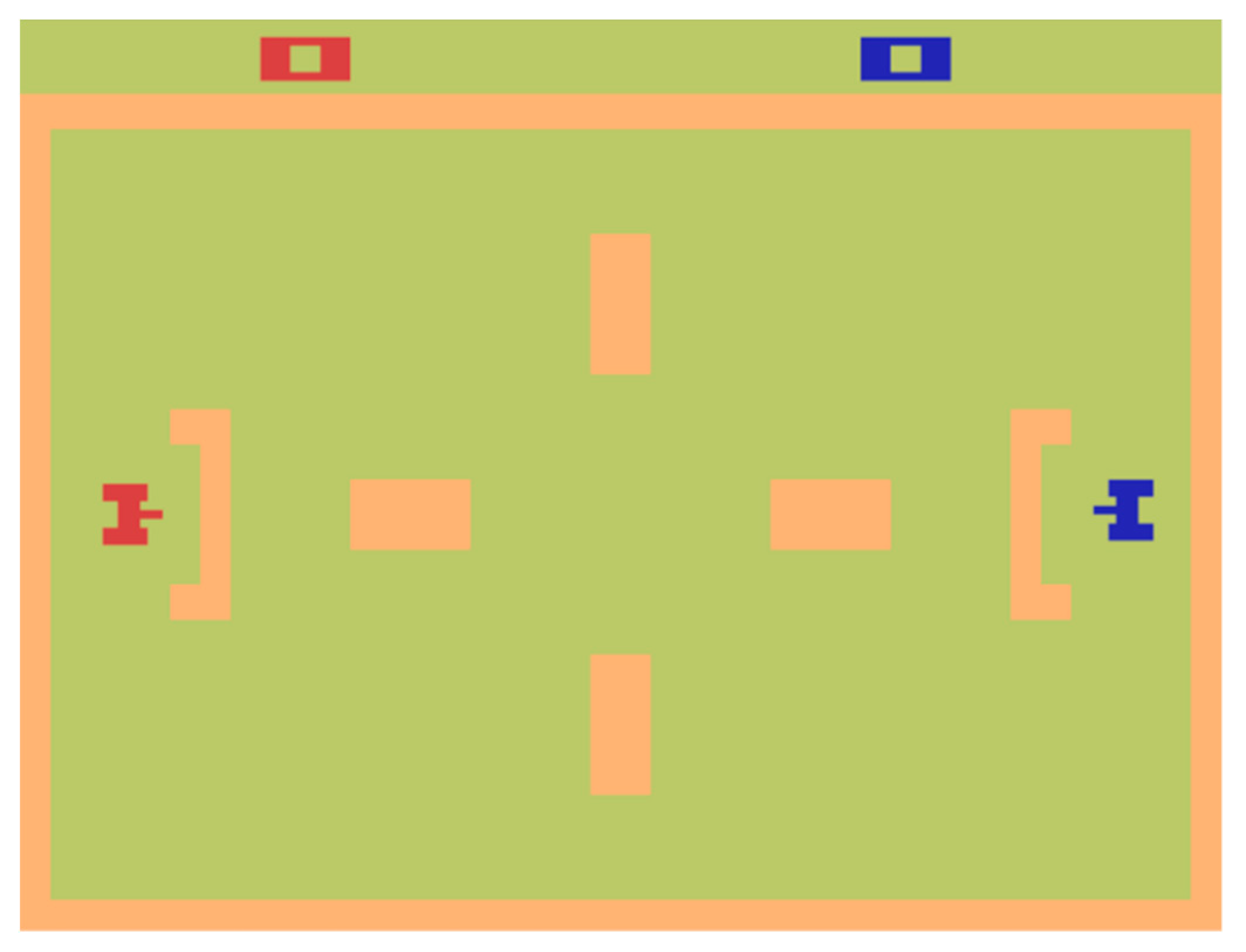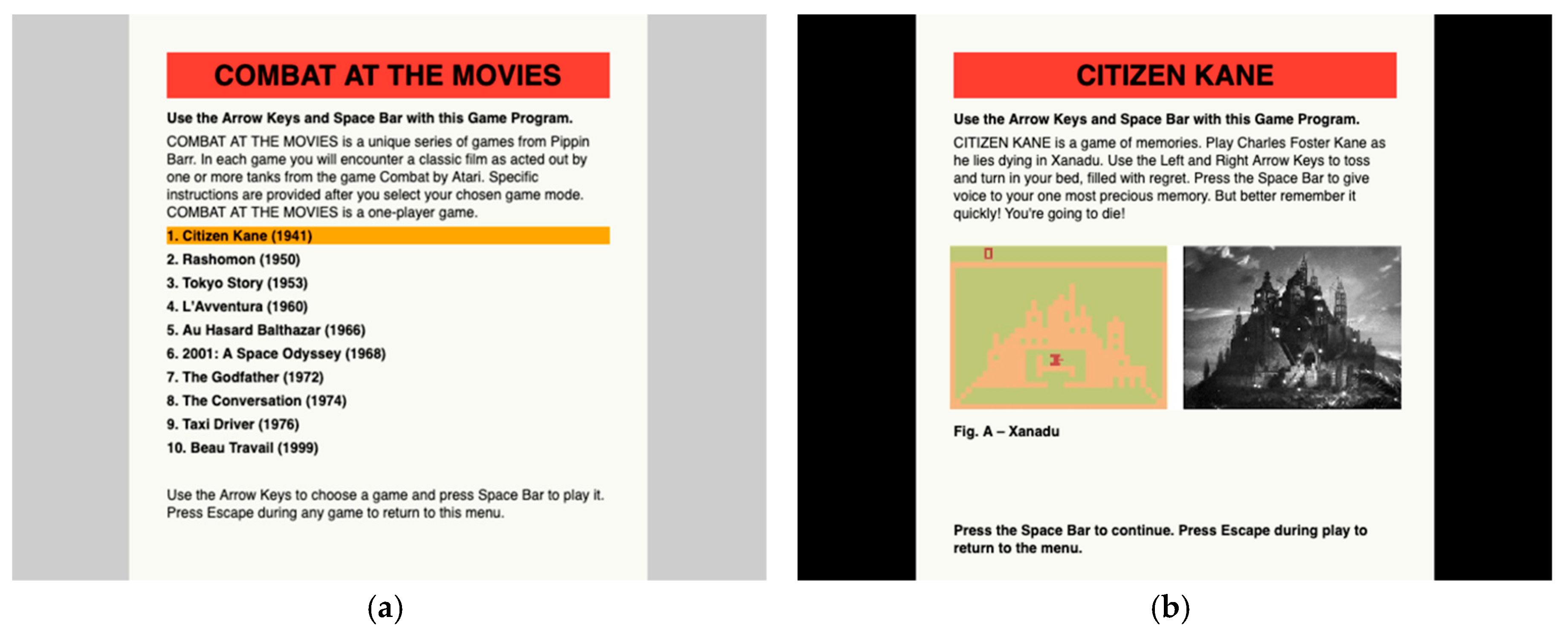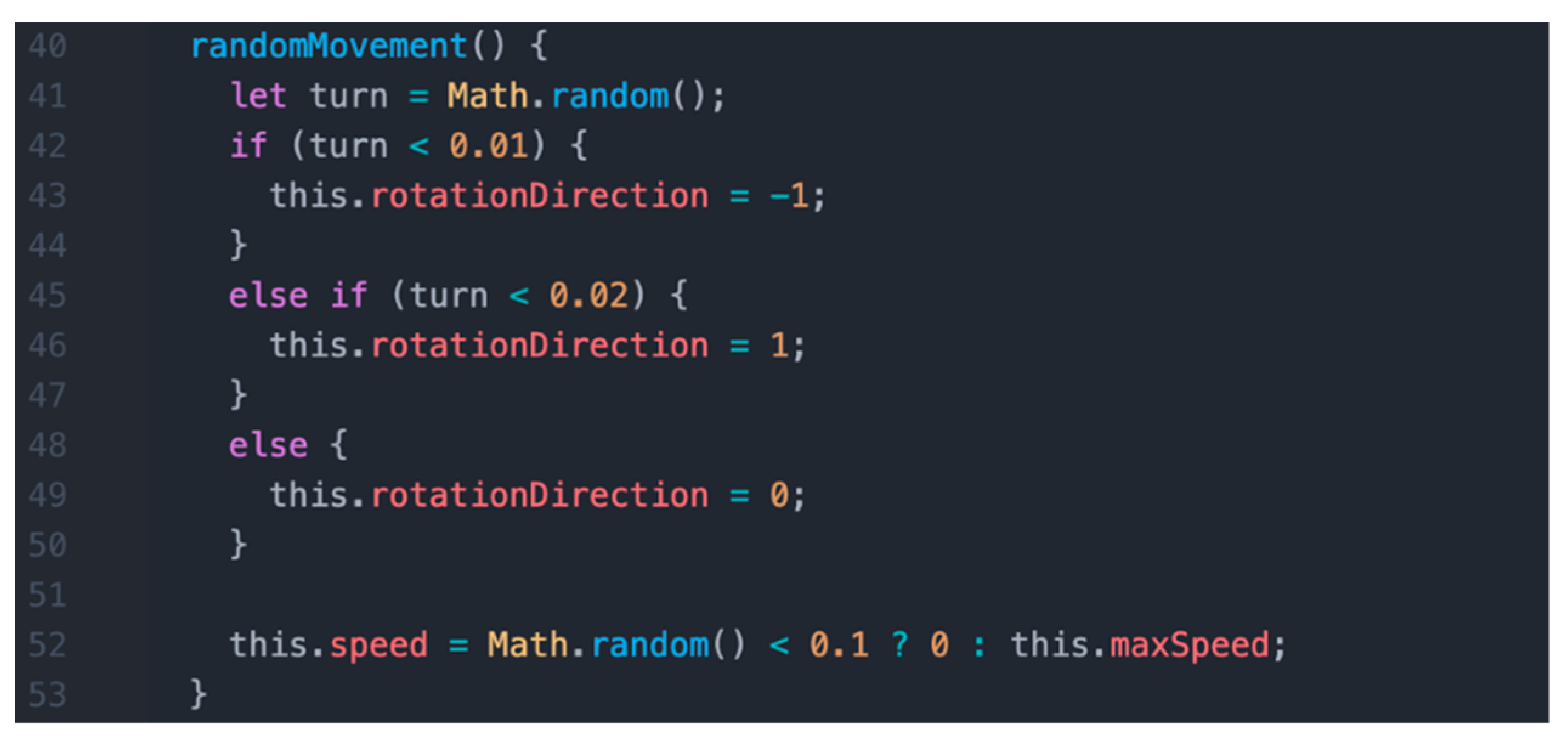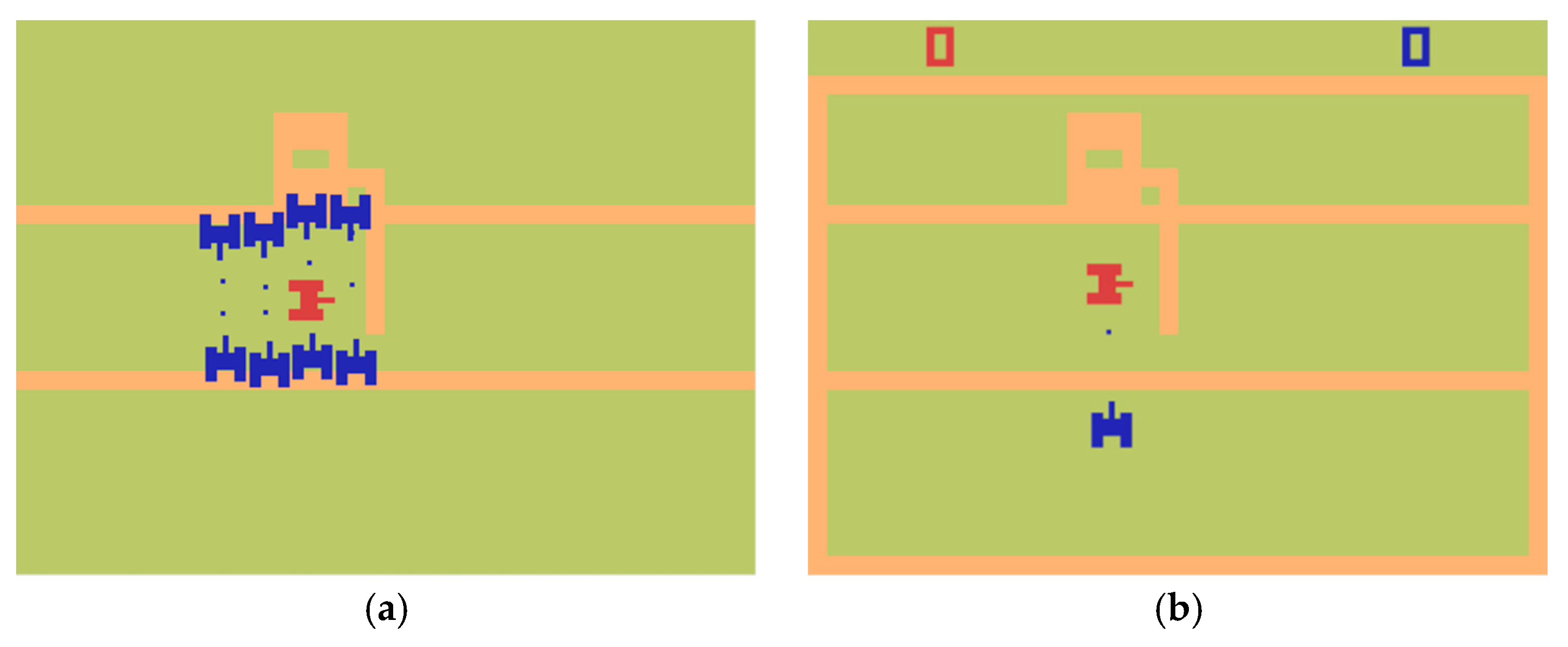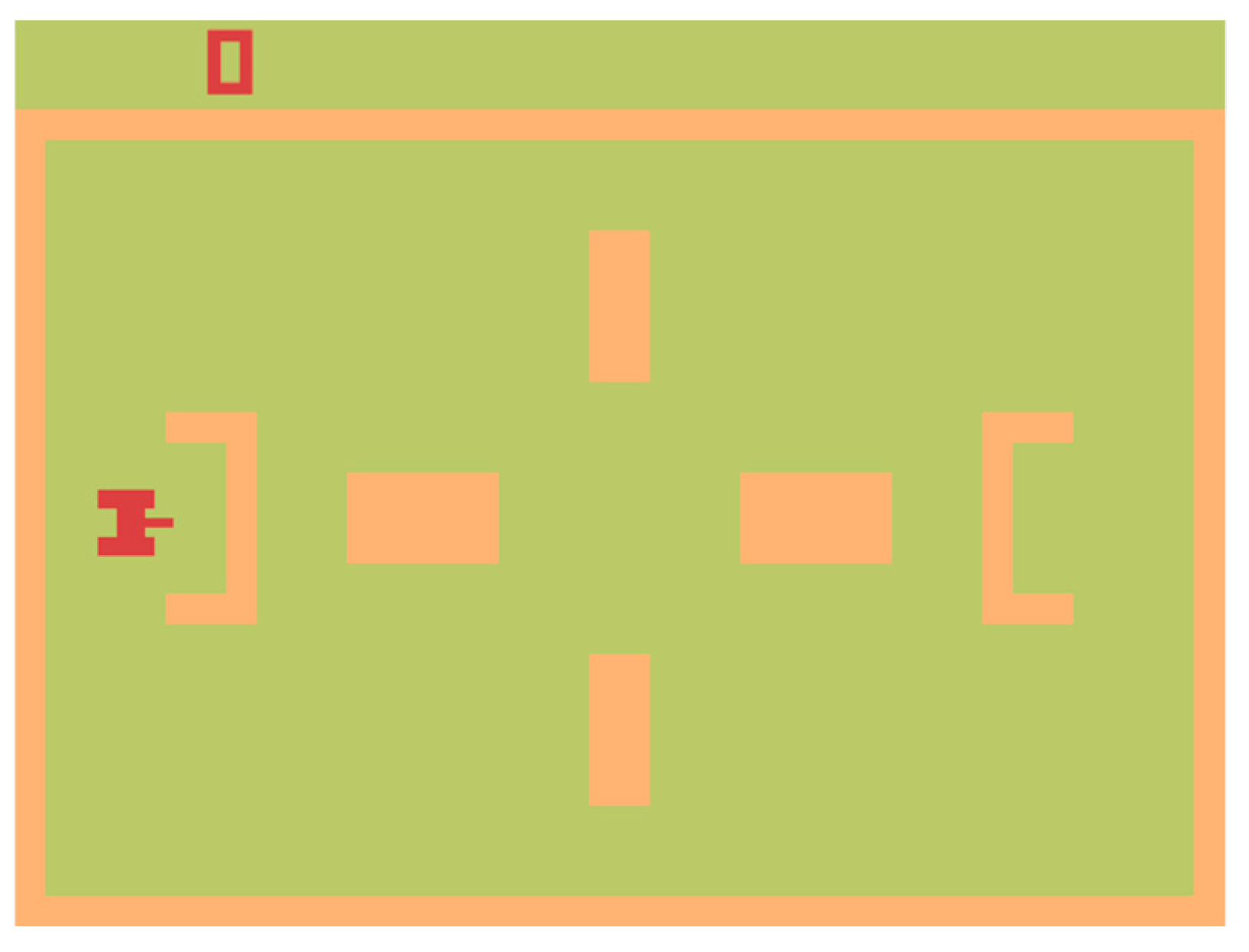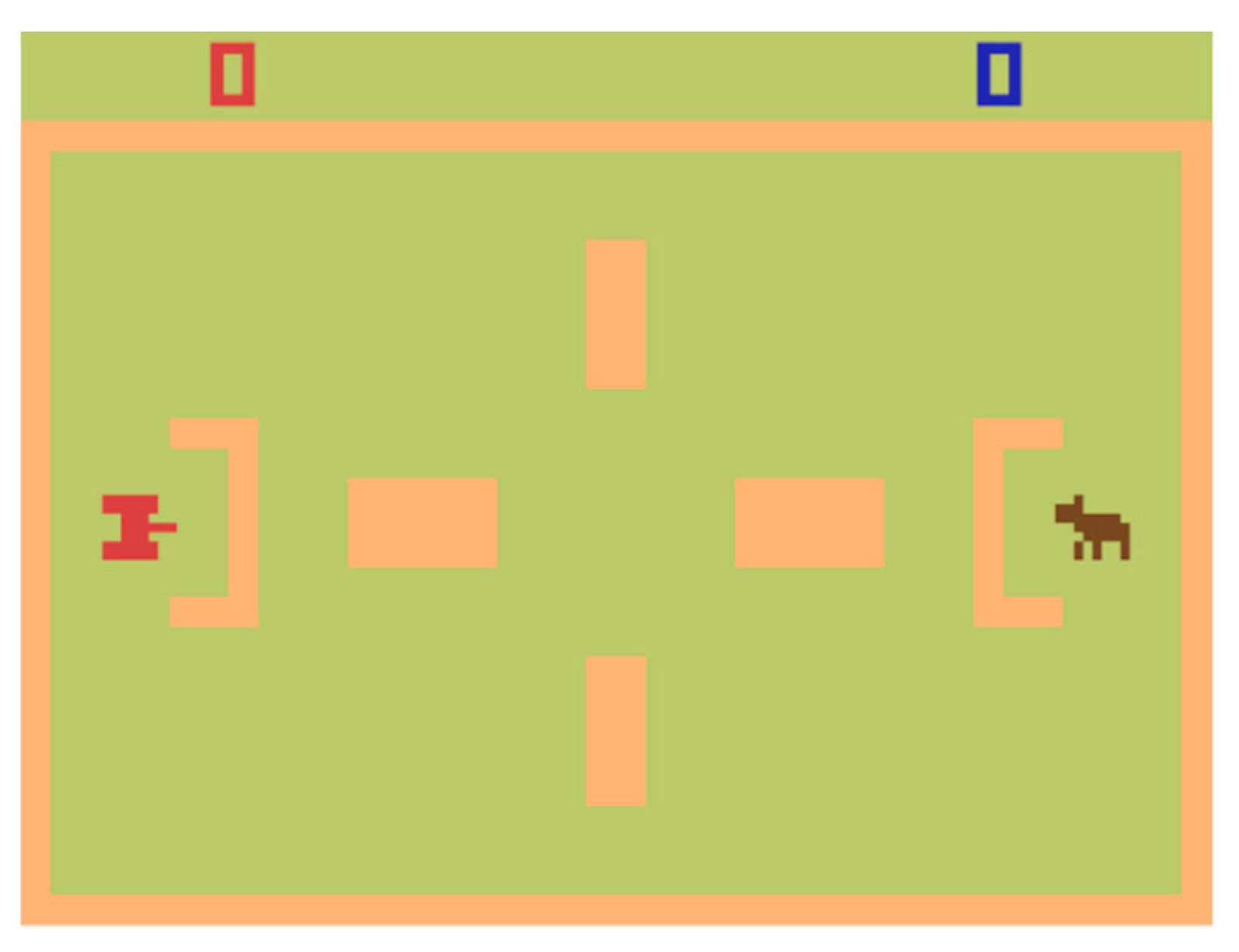The process of designing, developing, and documenting 10 film adaptations into the form of Atari’s game
Combat led to a significant amount of data. Foremost, are the games themselves, playable online, each reifying the overall project’s objectives to explore the potentials of film adaptation in a highly restrictive design context. Alongside this, the documentation of the project yielded over 10,000 words of process journal entries, over 5000 words of detailed technical commit messages, over 1500 words of “to do” tasks and completion notes, and over 1300 words of high-level design research discussion in the “why” document. All this data is publicly available in the game’s Git repository at
https://www.github.com/pippinbarr/combat-at-the-movies.
In reviewing the documentation, three key themes were identified as particularly worth discussing in the context of this exploration of film adaptation: adaptation in code, prioritizing Combat, and reframing violence. In the following subsections, I discuss these themes in detail alongside quotes from the process documentation and examples from the games themselves (including older versions). Seen together, these themes help us to reach an understanding of Combat at the Movies as a research design object that raises questions and points in potentially generative directions for film adaptation as an experimental videogame method.
4.1. Adaptation in Code
Beginning closest to the materials of game creation, it became clear that we can and should consider in some depth the direct relevance of the code itself when thinking about questions of adaptation. In terms of the specific adaptations pursued here, a recurring theme revolved around correspondences between film and underlying game code. This sometimes involved making sure that implementation details were true to the film being adapted. Thus, in
The Conversation, rather than variables (names for data in the program) representing the “red tank” and “blue tank”, the two tanks which fight it out in the unseen hotel room are named “husband” and “wife” in keeping with the film’s plot (
Figure 4). While such a low-level change has no bearing on the player’s experience, it both supported and further provoked a level of technical thoughtfulness in my design and development activities. Knowing that the code could (and perhaps should) be in sync with the surface-level representations led to my reflecting significantly more deeply on these potential correspondences and contradictions elsewhere.
Indeed, at other times, conventional game programming naming conventions served in part to interpret the film itself, such as in the case of Taxi Driver. Here, the effect of the player being able to see their tank in a mirror is produced by generating a second tank which mirrors the movements of the player’s tank. If I were pursuing a similar strategy of matching implementation to the truth of the movie, I might have called this second tank “mirror image” or something similar. In this case, however, the code uses the default variable name for the second tank that I had been using from the beginning of development: “enemy”. Thinking simply about a game of Combat, this makes sense as a name for the “other” tank that the player seeks to destroy, but for a tank used as a mirror image of the player, it serves further as an (unseen) intensifier of the scene itself: the mirror image really is Travis Bickle’s enemy, both because he is pretending to confront an unnamed stranger with his gun, but also in the sense that Bickle is his own antagonist here. Although a detail such as this is “buried” within the code itself, it does lend itself to an argument that the very implementation of film adaptation can serve as a form of film criticism and insight.
There are numerous other examples of these kinds of affinities and commentaries between code and film at work. The use of multiple “cameras”, a specific affordance within the Phaser 3 library for providing distinct views of a scene, to serve as a metaphor for the multiple perspectives in
Rashomon indicates that implementation details can move beyond literal translations to the figurative. In the opposite direction, the fact that the implementation of the donkey Balthazar’s movement through space in
Au Hasard Balthazar is a function called “randomMovement” provides a very literal correspondence between the “hasard” (chance) of the title and the behavior of its star (
Figure 5). Finally, in
L’Avventura there is the existential question of whether there should be, secretly and invisibly, a tank to represent the missing Anna in the film. To include this “Anna tank” in the underlying code would be to say that she is
somewhere, and simply cannot be found by the player. In the end, I felt this worked against the mysterious disappearance the film centers on, preferring for her not only to have vanished from the low-resolution island in the game, but from the very source code itself (
Figure 6).
Again, while a player of
Combat at the Movies will not be able to detect the above and other specifics of code, I believe there is a special beauty and authenticity to be found in tracking the adaptation process all the way to implementation details. Indeed, the discussion here reinforces that, in keeping with platform studies (
Bogost and Montfort 2009) and software studies (
Marino 2020), the code level is absolutely part of any complete analysis of a videogame. Furthermore, as indicated above, it seems clear that an adherence to this level of commitment could be fruitful both as a kind of game design film criticism (as with
Taxi Driver), as a way to maintain designer accountability to the source material (as with the attempt to be true to
L’Avventura by maintaining the mystery of Anna’s disappearance in code), and to follow design trajectories that might otherwise go unexplored.
4.2. Prioritizing Combat
In any process of adaptation, there is a need to determine our priorities: when they come into conflict, should we prioritize the source material or the medium we are adapting to? These moments of tension between film and videogame characterized many of the most generative design moments while working on
Combat at the Movies. As I worked, I found my way toward the principle that, generally speaking, I would privilege the target game form of
Combat (and its associated software, hardware, and design limits) and attempt to find the best
fit for the films I was adapting. This is very much a personal decision in keeping with my own practice of experimental videogame design. I have long privileged formal constraints of this nature in other projects, such as my translation of philosophical isms into the game form of the classic Snake game in
SNAKISMS,
36 or my adaptation of Greek mythologies of punishment to the platform of Windows 95-era user interface elements in
Let’s Play: Ancient Greek Punishment: UI Edition.
37As an example of formal limits posed by a target platform/game, consider that the Atari 2600 placed a precise limit on the number of sprites (dynamic visual elements) that could be displayed. Although this limit was exceeded by some games through pleasing tricks, I chose to stick with the key limitation of only two tank sprites. This core limitation is in no way enforced by the Phaser 3 library used to implement Combat at the Movies, which can support more or less arbitrary numbers of sprites on screen at the same time. Rather, I embraced the decision both as a form of authenticity, making the resulting game more recognizably in the style of Atari (and Combat specifically), as well as a way to find generative constraints for design.
The sprite limit led immediately to key decisions in at least two of the adaptations. In
The Conversation, in which the player listens to an unseen fight between two tanks representing the husband and wife from the movie, I had included a tank for the player to control
outside the battlefield, as if they were outside the wall of the hotel room. I later realized, however, that although the two tanks inside the hotel room were invisible to the player, they still necessarily counted as sprites in the game (having positions, collision detection, and more), placing the player’s tank in contravention of the sprite limit, as I noted in a commit message on the subject (
Figure 7). I removed the player’s tank and the game became one purely of listening, without the distraction of moving a tank around—in many ways very much more in keeping with its cinematic source.
In
The Godfather, the limitation had a more diminishing effect on the recreation of the toll plaza scene. Whereas in the film, Sonny Corleone is attacked by a multitude of Barzini’s men from all sides, the sprite limit of
Combat requires that the player tank be attacked by exactly one other tank. As with
The Conversation, I initially implemented the film with eight enemy tanks bearing down on the player (
Figure 8a) before recognizing it was not in keeping with
Combat. Thus, in the new version, the player drives through the plaza and is met with an ambush from just one other tank (
Figure 8b). The success or failure of this design decision in play rests on whether a player feels a greater loss at the ambush not being fully represented, or a greater sense of coherence at the basic structure of
Combat being maintained. Whatever the case, it is illustrative of a commitment to a specific design trajectory and how it interacts with the activity of adaptation.
A further source of generative tension resides at the level of the mechanics of Combat. As discussed earlier, Combat is a game with highly restrictive possibilities for player agency and outcomes, which boil down to driving and shooting and dying. All adaptations from the films chosen had to fit more or less within these basic forms of agency in the blocky Combat world. Thus, movement most often replicates the idea of traversing space toward some Other, but is also used to represent searching in L’Avventura, dancing in Beau Travail, and tossing and turning in bed in Citizen Kane. Shooting is “just shooting” in Au Hasard Balthazar and a stand-in for sword fighting in Rashomon, but also a trigger to “fire” out the line “you talkin’ to me?” in Taxi Driver and is completely absent in L’Avventura. Death, as will be discussed in depth below, takes on multiple forms too.
Beyond maintaining a fairly rigid adherence to the design norms of
Combat, there are also places in which a little more poetic license has been allowed to slip into the implementations of the films. In
Tokyo Story, where the player’s tank exists alone in the world, the movement and turning speeds have been adjusted downwards to emphasize the idea that the tank (in the role of Shūkichi Hirayama) is elderly (
Figure 9). In
Beau Travail, the ability to reverse has been added to the tank controls in order to expand the expressive language of movement available to the player in keeping with the beauty of the dancing in the movie.
In a way, the relationship between the selected films and the established framework of Combat serves as an illustration of the nature of adaptation itself: a series of pointed compromises between the source and the new work. In order to “pick a side” at each moment of tension, the designer must think explicitly and in some depth about both sides of the equation, suggesting this form of adaptation may be a particularly useful exercise in videogame design thinking as much as a means to create a final product.
4.3. Reframing Violence
As introduced in
Section 2.1, this project was intended not only to explore the adaptation of non-blockbuster films into a constrained videogame language, but also to use this process as an opportunity to comment on videogame violence. The games in
Combat at the Movies each involve a direct or implied relationship to death and/or violence that complicates or outright contradicts standard videogame interpretations of these ideas. Each game presents, thanks to its cinematic source, a different way of thinking about what it means to kill, to be killed, to die, or to act violently. While I will not discuss every game here, I will provide three examples to clarify what I mean by this.
A useful place to start is with
Taxi Driver. Here, as in many games, the player assumes the role of a violent character, Travis Bickle. Bickle is in some ways a lot like the
Combat tank, bent toward destruction and death, but here we find Bickle at home in front of his mirror rather than in an arena for battle. In the game, the player confronts their reflection in the mirror and speaks the famous line, “you talkin’ to me?” (
Figure 10). The violence is detuned in the literal sense that no shots are fired and nobody dies. Instead, the player goes through the motions of threatening an imagined adversary. This idea of a precursor to violence, of an antagonist working themselves up into the emotional state needed to commit murder, is rarely thought of or included in game designs. Taken seriously, it draws the violence of the tank outside the cycle of kill-and-be-killed in a way that may make it at least somewhat affectively accessible. In a sense, the
Taxi Driver adaptation could be read not just as an adaptation of a movie, but almost a vision of an imaginary “locker room” in which the original
Combat tank psyches itself up for battle.
More straightforwardly,
Au Hasard Balthazar presents the player with a simple choice: Balthazar, the donkey, wanders the screen aimlessly and the player can kill him or not (
Figure 11). The donkey is of no threat and can be killed without any official negative consequence, such as loss of points. Despite the fairly obvious
moral answer to this “dilemma” (leave the poor donkey alone), many players may feel that killing Balthazar is the implied goal, or at least desirable, because it is the most
active way to play. This premise in videogame play that if one
can do something (such as kill) then one
should, or at the very least should
try it out, is at the heart of many internal justifications for “unnecessary” violent acts in play. This essential cruelty that players exhibit toward virtual characters, killing or wounding them because they can, is very much in keeping with the arbitrary and needless cruelty of many of the people we meet in
Au Hasard Balthazar the film. Whether or not a player of the game feels even a modicum of remorse on killing the innocent donkey (or conversely any satisfaction at leaving him alone), they take part in a videogame mirror of the world Bresson presented to us.
To choose one final adaptation to illustrate these ideas, consider
The Conversation. Here, as already stated, the player is not the enactor of violence, and indeed does not even have a controllable representation in the world of the game. Rather, they
listen to the violence of invisible others and, per the plot of the movie itself, seek to discern what is happening behind closed doors. Bearing witness to violence and death rather than being its agent is another underused approach to violence in the context of videogames, where players are ordinarily placed in positions to act violently toward others for various reasons, such as war (e.g.,
Call of Duty38), saving damsels in distress (e.g.,
Super Mario Bros.
39), or simple criminal cruelty (e.g., the
Grand Theft Auto series
40). In removing the player’s ability to act decisively with violence but maintaining a violent world, the player of
The Conversation is asked to bear witness instead of jumping in themselves. While there are games that use this approach (most notably
Return of the Obra Dinn41), it strikes me as a significantly powerful direction of investigation for game designers interested in engaging with violence as a human concern.
Without going into the knotty debate on the impact of violence in games, we can at least agree that the treatment of violence in games trends toward trivialization or, at best, a prioritization of fun and tests of skill. Adapting non-action-oriented films, all of which still intersect with an idea of violence or death in some way, gave me a chance to consider a diverse set of alternate approaches, as illustrated above. In practice, this exploration led to the idea that film adaptation (outside the world of blockbusters) could be a generative source of other understandings of violence and that the specific design results could be used as principles in games which are not explicitly adaptations, much in the way they have borrowed from films’ visual language.
